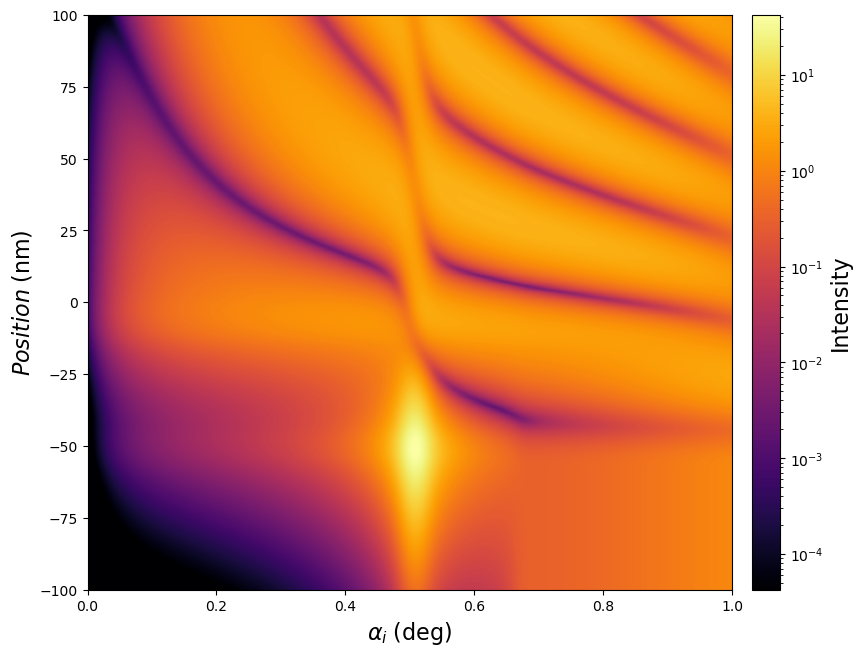1
2
3
4
5
6
7
8
9
10
11
12
13
14
15
16
17
18
19
20
21
22
23
24
25
26
27
28
29
30
31
32
33
34
35
36
37
38
39
40
41
42
43
44
45
46
47
48
49
50
51
52
53
54
55
56
57
58
59
60
61
62
63
64
65
66
67
68
69
70
71
72
73
74
75
76
77
78
79
80
81
82
83
84
85
86
87
88
|
#!/usr/bin/env python3
"""
Basic example of depth-probe simulation with BornAgain.
Sample layers are Si | Ti | Pt | Ti | TiO2 | D2O.
Beam comes from Si side.
Therefore we model the stack with Si on top.
The z axis points from D2O to Si; z=0 is at the Si/Ti interface.
"""
import bornagain as ba
from bornagain import angstrom, deg, nm, nm2, kvector_t
# layer thicknesses in angstroms
t_Ti = 130*angstrom
t_Pt = 320*angstrom
t_Ti_top = 100*angstrom
t_TiO2 = 30*angstrom
# beam data
ai_min = 0 # minimum incident angle
ai_max = 1*deg # maximum incident angle
n_ai_bins = 5000 # number of bins in incident angle axis
beam_sample_ratio = 0.01 # beam-to-sample size ratio
wl = 10*angstrom # wavelength in angstroms
# convolution parameters
d_ang = 0.01*ba.deg # spread width for incident angle
n_points = 25 # number of points to convolve over
n_sig = 3 # number of sigmas to convolve over
# depth position span
z_min = -100*nm
z_max = 100*nm
n_z_bins = 500
def get_sample():
"""
Constructs a sample with one resonating Ti/Pt layer
"""
# Define materials
material_D2O = ba.HomogeneousMaterial("D2O", 0.00010116, 1.809e-12)
material_Pt = ba.HomogeneousMaterial("Pt", 0.00010117, 3.01822e-08)
material_Si = ba.HomogeneousMaterial("Si", 3.3009e-05, 0)
material_Ti = ba.HomogeneousMaterial("Ti", -3.0637e-05, 1.5278e-08)
material_TiO2 = ba.HomogeneousMaterial("TiO2", 4.1921e-05, 8.1293e-09)
# Define layers
layer_1 = ba.Layer(material_Si)
layer_2 = ba.Layer(material_Ti, 13*nm)
layer_3 = ba.Layer(material_Pt, 32*nm)
layer_4 = ba.Layer(material_Ti, 10*nm)
layer_5 = ba.Layer(material_TiO2, 3*nm)
layer_6 = ba.Layer(material_D2O)
# Define sample
sample = ba.MultiLayer()
sample.addLayer(layer_1)
sample.addLayer(layer_2)
sample.addLayer(layer_3)
sample.addLayer(layer_4)
sample.addLayer(layer_5)
sample.addLayer(layer_6)
return sample
def get_simulation(sample):
"""
Returns a depth-probe simulation.
"""
alpha_distr = ba.DistributionGaussian(0, d_ang)
footprint = ba.FootprintSquare(beam_sample_ratio)
simulation = ba.DepthProbeSimulation()
simulation.setBeamParameters(wl, n_ai_bins, ai_min, ai_max, footprint)
simulation.setZSpan(n_z_bins, z_min, z_max)
simulation.addParameterDistribution("*/Beam/InclinationAngle",
alpha_distr, n_points, n_sig)
simulation.setSample(sample)
return simulation
if __name__ == '__main__':
import ba_plot
sample = get_sample()
simulation = get_simulation(sample)
ba_plot.run_and_plot(simulation, aspect='auto')
|

